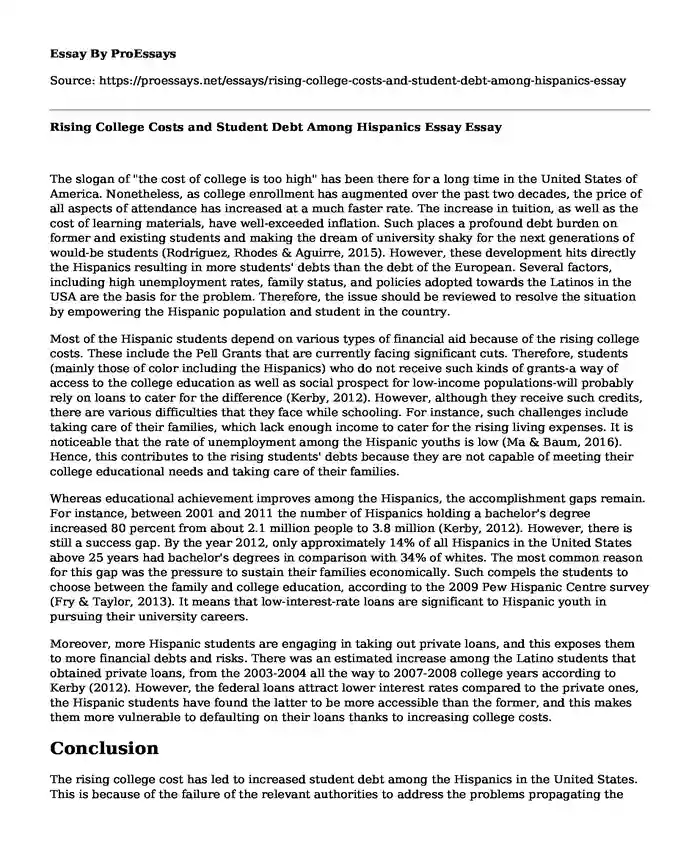The slogan of "the cost of college is too high" has been there for a long time in the United States of America. Nonetheless, as college enrollment has augmented over the past two decades, the price of all aspects of attendance has increased at a much faster rate. The increase in tuition, as well as the cost of learning materials, have well-exceeded inflation. Such places a profound debt burden on former and existing students and making the dream of university shaky for the next generations of would-be students (Rodriguez, Rhodes & Aguirre, 2015). However, these development hits directly the Hispanics resulting in more students' debts than the debt of the European. Several factors, including high unemployment rates, family status, and policies adopted towards the Latinos in the USA are the basis for the problem. Therefore, the issue should be reviewed to resolve the situation by empowering the Hispanic population and student in the country.
Most of the Hispanic students depend on various types of financial aid because of the rising college costs. These include the Pell Grants that are currently facing significant cuts. Therefore, students (mainly those of color including the Hispanics) who do not receive such kinds of grants-a way of access to the college education as well as social prospect for low-income populations-will probably rely on loans to cater for the difference (Kerby, 2012). However, although they receive such credits, there are various difficulties that they face while schooling. For instance, such challenges include taking care of their families, which lack enough income to cater for the rising living expenses. It is noticeable that the rate of unemployment among the Hispanic youths is low (Ma & Baum, 2016). Hence, this contributes to the rising students' debts because they are not capable of meeting their college educational needs and taking care of their families.
Whereas educational achievement improves among the Hispanics, the accomplishment gaps remain. For instance, between 2001 and 2011 the number of Hispanics holding a bachelor's degree increased 80 percent from about 2.1 million people to 3.8 million (Kerby, 2012). However, there is still a success gap. By the year 2012, only approximately 14% of all Hispanics in the United States above 25 years had bachelor's degrees in comparison with 34% of whites. The most common reason for this gap was the pressure to sustain their families economically. Such compels the students to choose between the family and college education, according to the 2009 Pew Hispanic Centre survey (Fry & Taylor, 2013). It means that low-interest-rate loans are significant to Hispanic youth in pursuing their university careers.
Moreover, more Hispanic students are engaging in taking out private loans, and this exposes them to more financial debts and risks. There was an estimated increase among the Latino students that obtained private loans, from the 2003-2004 all the way to 2007-2008 college years according to Kerby (2012). However, the federal loans attract lower interest rates compared to the private ones, the Hispanic students have found the latter to be more accessible than the former, and this makes them more vulnerable to defaulting on their loans thanks to increasing college costs.
Conclusion
The rising college cost has led to increased student debt among the Hispanics in the United States. This is because of the failure of the relevant authorities to address the problems propagating the menace. The major problems propagating the rising cost and student debt include students supporting their family finances, limited access to federal education loans, and high unemployment rates among the Latino students. Therefore, the government and the society ought to improve on the issue to ensure that all college students have a chance to enroll and successively graduate from this institution by championing effective policies.
References
Fry, R., & Taylor, P. (2013). Hispanic High School Graduates Pass Whites in Rate of College Enrollment.
Kerby, S. (2012). How Student Debt Impacts Students of Color - Center for American Progress. Retrieved from https://www.americanprogress.org/issues/education-postsecondary/news/2012/04/26/11375/how-student-debt-impacts-students-of-color/
Ma, J., & Baum, S. (2016). Trends in community colleges: Enrollment, prices, student debt, and completion. College Board Research Brief.
Rodriguez, E., Rhodes, K., & Aguirre, G. (2015). Intervention for high school Latino students in preparing for college: Steps for consideration. Journal of Hispanic Higher Education, 14(3), 207-222.
Cite this page
Rising College Costs and Student Debt Among Hispanics Essay. (2022, Jul 20). Retrieved from https://proessays.net/essays/rising-college-costs-and-student-debt-among-hispanics-essay
If you are the original author of this essay and no longer wish to have it published on the ProEssays website, please click below to request its removal:
- Paper Example on Childhood Trauma
- Autism in Preschoolers Essay Example
- Paper Example on Teaching Nursing Education
- Essay Sample on Kids' Overburdened with School Homework: Reduce Number of Assignments!
- Tax Evasion: A Serious Crime With Serious Consequences - Essay Sample
- Essay on Observation Cycle for Science Teacher: Preconferencing, Observation, and Analysis
- Essay Example on Video Games: Practical Skill Development for Education & Learning







